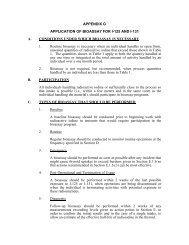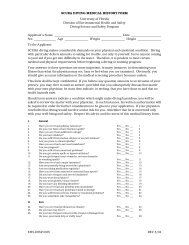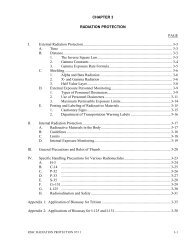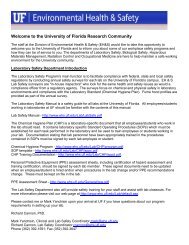CHAPTER 2 FUNDAMENTAL RADIATION CONCEPTS PAGE I ...
CHAPTER 2 FUNDAMENTAL RADIATION CONCEPTS PAGE I ...
CHAPTER 2 FUNDAMENTAL RADIATION CONCEPTS PAGE I ...
- No tags were found...
Create successful ePaper yourself
Turn your PDF publications into a flip-book with our unique Google optimized e-Paper software.
<strong>FUNDAMENTAL</strong> <strong>RADIATION</strong> <strong>CONCEPTS</strong>I. WHAT IS <strong>RADIATION</strong>?Radiation is defined as energy that travels through space or matter in the form of aparticle or wave. It can be produced in one of two ways: by radioactive decay of anunstable atom (radionuclide), or by the interaction of a particle with matter. Someattributes of radioactive decay are that it is spontaneous and random, and the type ofradiation emitted depends on the specific radionuclide. Radiation emission as the result ofan interaction, on the other hand, depends on both the incoming particle and the materialit hits, and is theoretically predictable if enough information is known. (In reality, it isimpossible to obtain enough information to make predictions about radiation emissionfrom a single incoming particle, but it is possible to make statistical predictions aboutlarge numbers of particles.) Radioactive decay and interactions will be discussed in moredetail in the following sections.Radiation is described by its type and energy. The types of radiation fall into two maincategories: particulate and electromagnetic. Particulate radiation consists of particles thathave mass and energy, and may or may not have an electric charge. Examples ofparticulate radiation include alpha particles, protons, beta particles, and neutrons.Electromagnetic radiation, on the other hand, consists of photons that have energy, but nomass or charge. A photon, as described by quantum theory, is a "particle" or "quantum"that contains a discrete quantity of electromagnetic energy which travels at the speed oflight, or 3 x 10 8 meters per second. A photon is sometimes described as a “packet oflight”. Visible light, ultraviolet light, x-rays, and gamma rays are all photons.The most common unit of energy used to describe radiation is the electronvolt (eV). Anelectronvolt is the amount of kinetic energy an electron gains when accelerated through apotential difference of one volt. The conversion to SI units is 1 eV = 1.6x10 -19 joules. AneV is a very small unit of energy, so in many applications, it is more common to use kiloelectronvolts(1 keV = 1000 eV) or mega-electronvolts (1 MeV = 1,000,000 eV).Radiation can be either ionizing or non-ionizing, depending on its energy and ability topenetrate matter. Non-ionizing radiation, such as visible light, is not harmful. Onlyionizing radiation is discussed in this course. Ionization is discussed in more detail onpage 11.II.THE RADIOACTIVE ATOMAll matter is composed of atoms. The atom contains a nucleus, consisting of protons andneutrons, with electrons revolving in orbits about the nucleus. Electrons carry a negativecharge, protons carry a positive charge, and neutrons have no electrical charge. An atomnormally has one electron in orbit for each proton in the nucleus, leaving the atom2-2 RSSC <strong>FUNDAMENTAL</strong> <strong>RADIATION</strong> <strong>CONCEPTS</strong> 072011












